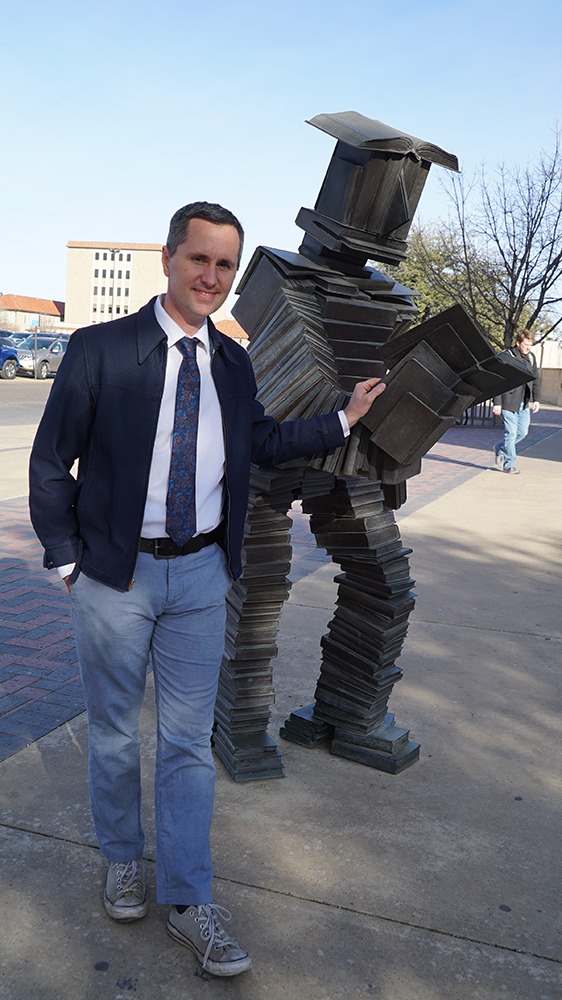PopWalk App Creates Realtime Art Experience Beyond Museum Walls
By: Hannah Fields
Imagine having the ability to access art wherever you go and having the ability to listen to an artist speak about their work, even if they aren't around. Though this might sound too good to be true, David Lindsay, artist and art professor at Texas Tech University, has made this a possibility through his creation of the PopWalk App.
Lindsay first dreamed up the concept of PopWalk while he was a resident artist in Germany. While working on a project to emulate the beauty of a local stone church through animation, Lindsay realized after he made that video, he would take it home with him and no one in Germany would be able to access that video in the specific place it was meant to be seen. It was at that moment that he saw the need for a tool to display art in the environment it was meant to be seen in, thus enriching the art and experience of seeing the place around it.
However, it wasn't just Lindsay's experience in Germany that influenced his app creation, but from observations at home.
“When I moved from painting to animation, I would watch my teenage son watch YouTube videos in his pajamas on the couch and I thought, ‘That is the worst way I want people to look at my artwork,'” Lindsay said. “I don't want them to look at and see these animations I'm doing while sitting in their pajamas on the couch. So I thought the best way to show the video is in a specific context and in a place where it is meant to be seen.”
To give this method a more unique approach, Lindsay had geofencing built into the PopWalk App. Geofencing acts as a virtual geographic boundary, or fence, which enables software to trigger a response when a mobile device enters or leaves a particular area. When used in the app, geofencing can guide viewers to specific artworks and act as an access code to accompanying artist videos.

While geofencing has made the app more user friendly, it wasn't implemented until the final stages of the app's two and a half year development. At the beginning, the app required a QR code sign, which was first used at the Texas Tech University Will Rogers statue. Viewers could scan the code sign near the statue and view its accompanying video through the app. Lindsay made the decision to move from QR code signs to geofencing because it eliminated the need for signs and created ease of access for viewers.
The development process also included a collaboration between Lindsay and the Texas Tech Public Art program. Together they worked with artists who have art displayed across the Texas Tech campus to create around 60 video interviews of each artist speaking about their work. This process, Lindsay said, has opened up more areas of the campus than he's seen during his ten previous years teaching here.
“There's so much to see and I think it's easy for us to get caught up in our own little corner of the world,” Lindsay said. “What this does is open up some of the more beautiful parts of campus public artwork, and it allows us to have a way to know where those works are and to have the artists talk about them.”
The app has also been utilized beyond the Texas Tech campus. For example, the Lubbock Flatlands Dance Theatre recorded a site-specific dance around the Louise Hopkins Underwood Center for the Arts (LHUCA) that is available for viewers to watch in that location. PopWalk can also be used during Lubbock's First Friday Art Trail, especially at LHUCA.
PopWalk is also making its way beyond Lubbock city limits. Lindsay said art administrators from Odessa, Wichita Falls, Abilene and Amarillo have contacted him about using the app to display or enhance what they are doing with their own public art collection.
But, it's not just art administrators who are interested in the app, but individual artists who are utilizing it as an invaluable tool to showcase their art to more viewers, which is something Lindsay intended it to be used for.
“I think it's a wonderful tool, not just for artists, but for performers, musicians, and the like, to be able to tell us about any location in the world,” Lindsay said. “I think it has a potential to develop empathy in people. You can see a place on television and think, ‘Oh, that's really great or really terrible what's going on there,' but to go to that place, to hear the voices of those people, to see their thoughts on that location—that helps you feel what it's like to be in that place.”
PopWalk has especially given a voice to Houston through its current call for art competition following hurricane Harvey. The art called for in this competition is meant to commemorate and celebrate Houston. Artists will have the ability to put up videos around Houston in a way to remember that specific place as it was before the hurricane.
The app has even been utilized by several artists in Germany, New York, India, and Sri Lanka. As word spreads about PopWalk, Lindsay hopes that it becomes something that brings people together through their stories.
“This is my intention, to open up all of those little places in the world that have wonderful stories that people can tell us that we wouldn't hear about without that person standing here to tell us,” Lindsay said.
PopWalk is available to download for free in both the iTunes and Android stores.
Discoveries
-
Address
Texas Tech University, 2500 Broadway, Box 41075 Lubbock, TX 79409 -
Phone
806.742.3905 -
Email
vpr.communications@ttu.edu
